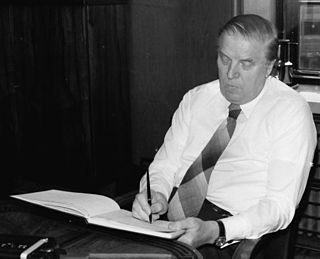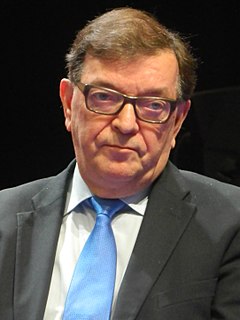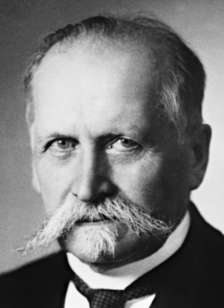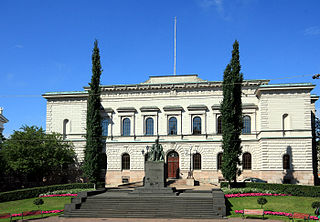
Taisto Kalevi Sorsa was a Finnish politician who served as Prime Minister of Finland three times: 1972–1975, 1977–1979 and 1982–1987. At the time of his death he still held the record for most days of incumbency as prime minister. He was also a long-time leader of the Social Democratic Party of Finland.

The Centre Party of Finland is a centrist, liberal, agrarian political party in Finland.

Johannes Virolainen was a Finnish politician and who served as 30th Prime Minister of Finland.

Karl-August Fagerholm was Speaker of Parliament and three times Prime Minister of Finland. Fagerholm became one of the leading politicians of the Social Democrats after the armistice in the Continuation War. As a Scandinavia-oriented Swedish-speaking Finn, he was believed to be more to the taste of the Soviet Union's leadership than his predecessor Väinö Tanner. Fagerholm's post-war career was however marked by fierce opposition from both the Kremlin and domestic communists. He narrowly lost the presidential election to Urho Kekkonen in 1956.

Paavo Matti Väyrynen is a Finnish veteran politician and a member of the Finnish Parliament, representing the Seven Star Movement and formerly the Citizen's Party and Centre Party. Väyrynen has been a member of the Finnish Parliament previously from 1970 to 1995 and again from 2007 to 2011 and has held many ministerial portfolios. He has also been a Member of the European Parliament from 1995 to 2007, and again from 2014 to 2018.
Parliamentary elections were held in Finland on 15 and 16 March 1970.
Parliamentary elections were held in Finland on 2 and 3 January 1972.
Parliamentary elections were held in Finland on 18 and 19 March 1979.
Parliamentary elections were held in Finland on 15 and 16 March 1987.

Eino Oskari Uusitalo was a Finnish politician from the Centre Party. He was born in Soini.

Presidential elections were held in Finland in 1988. They were the first elections held under a new system. Previously, the public had elected an electoral college that in turn elected the President. For this election, the public directly elected the President on 31 January and 1 February, but also elected an electoral college that would elect the President if no candidate won over 50% of the popular vote. The college was increased in size from 300 to 301 seats to make a tie less likely, though this was still technically possible, as electors could abstain from voting.

Two-stage presidential elections were held in Finland in 1937. On 15 and 16 January the public elected presidential electors to an electoral college. They in turn elected the President. Whilst Kaarlo Juho Ståhlberg was one vote short of winning on the first ballot, the result was a victory for Kyösti Kallio, who won on the second ballot. The turnout for the popular vote was 57.8%.

Two-stage presidential elections were held in Finland in 1950, the first time the public had been involved in a presidential election since 1937 as three non-popular elections had taken place in 1940, 1943 and 1946. On 16 and 17 January the public elected presidential electors to an electoral college. They in turn elected the President. The result was a victory for Juho Kusti Paasikivi, who won on the first ballot. The turnout for the popular vote was 63.8%. President Paasikivi was at first reluctant to seek re-election, at least in regular presidential elections. He considered asking the Finnish Parliament to re-elect him through another emergency law. Former President Ståhlberg, who acted as his informal advisor, persuaded him to seek re-election through normal means when he bluntly told Paasikivi: "If the Finnish people would not bother to elect a President every six years, they truly would not deserve an independent and democratic republic." Paasikivi conducted a passive, "front-porch" style campaign, making few speeches. By contrast, the Agrarian presidential candidate, Urho Kekkonen, spoke in about 130 election meetings. The Communists claimed that Paasikivi had made mistakes in his foreign policy and had not truly pursued a peaceful and friendly foreign policy towards the Soviet Union. The Agrarians criticized Paasikivi more subtly and indirectly, referring to his advanced age, and speaking anecdotally about aged masters of farmhouses, who had not realized in time that they should have surrendered their houses' leadership to their sons. Kekkonen claimed that the incumbent Social Democratic minority government of Prime Minister K.A. Fagerholm had neglected the Finnish farmers and the unemployed. Kekkonen also championed a non-partisan democracy that would be neither a social democracy nor a people's democracy. The Communists hoped that their presidential candidate, former Prime Minister Mauno Pekkala, would draw votes away from the Social Democrats, because Pekkala was a former Social Democrat. The Agrarians lost over four per cent of their share of the vote compared to the 1948 parliamentary elections. This loss ensured Paasikivi's re-election. Otherwise Kekkonen could have been narrowly elected President - provided that all the Communist and People's Democratic presidential electors would also have voted for him.

Two-stage presidential elections were held in Finland in 1956. On 16 and 17 January the public elected presidential electors to an electoral college. They in turn elected the President. The result was a victory for Urho Kekkonen, who won on the third ballot over Karl-August Fagerholm. The turnout for the popular vote was 73.4%. Kekkonen had been Juho Kusti Paasikivi's heir apparent since the early 1950s, given his notable political skills for building coalitions, bargaining, risk-taking and adjusting his tactics, actions and rhetoric with regard for the prevailing political wind. On the other hand, his behaviour and political tactics, including sharp-tongued speeches and writings, utilization of political opponents' weaknesses, and rather close relations with the Soviet leaders, were severely criticized by several of his political opponents. Kekkonen's colourful private life, including occasional heavy drinking and at least one extramarital affair, also provided his fierce opponents with verbal and political weapons to attack him. Several other presidential candidates were also criticized for personal issues or failures. Despite all the anti-Kekkonen criticism, his political party, the Agrarians, succeeded for the first time in getting the same share of the vote in the presidential elections' direct stage as in the parliamentary elections. President Paasikivi had neither publicly agreed nor refused to be a presidential candidate. He considered himself morally obliged to serve as President for a couple of more years, if many politicians urged him to do so. Between the first and second ballots of the Electoral College, one National Coalitioner phoned him, asking him to become a dark-horse presidential candidate of the National Coalitioners, Swedish People's Party and People's Party (liberals). At first, Paasikivi declined, requiring the support of Social Democrats and most Agrarians. Then he moderated his position, but mistakenly believed that he would receive enough Social Democratic, Agrarian and Communist and People's Democratic electors' votes to advance to the crucial third ballot. This did not happen, because all Agrarian electors remained loyal to Kekkonen, all Social Democratic electors remained loyal to Fagerholm, and the Communist and People's Democratic electors split their votes to help Fagerholm and Kekkonen advance to the third ballot. The bitterly annoyed and disappointed President Paasikivi publicly denied his last-minute presidential candidacy two days later. Kekkonen was elected President with the narrowest possible majority, 151 votes to 149. For several decades, the question of who cast the decisive vote for him has been debated among Finnish politicians and some Finnish journalists.

Two-stage presidential elections were held in Finland in 1962. On 15 and 16 January the public elected presidential electors to an electoral college. They in turn elected the President. The result was a victory for Urho Kekkonen, who won on the first ballot. The turnout for the popular vote was 81.5%.

Two-stage presidential elections were held in Finland in 1978, the first since 1968 after Urho Kekkonen's term was extended by four years by Parliament. The public elected presidential electors to an electoral college on 15 and 16 January. They in turn elected the President. The result was a victory for Urho Kekkonen, who won on the first ballot. The turnout for the popular vote was 64.3. Kekkonen had in the spring of 1975 agreed to become the Social Democratic presidential candidate, and after that all the major Finnish political parties chose him as their candidate. Kekkonen's opponents, such as the Christian League's presidential candidate Raino Westerholm, claimed that Kekkonen's long presidency weakened the Finnish democracy. Over one-third of the Finnish voters abstained from voting, partly as a protest against Kekkonen's expected landslide victory.

The United States elections of 1788–89 were the first federal elections in the United States since the ratification of the United States Constitution in 1788. In the elections, the George Washington was elected as the first president and the members of the 1st United States Congress were selected.






















